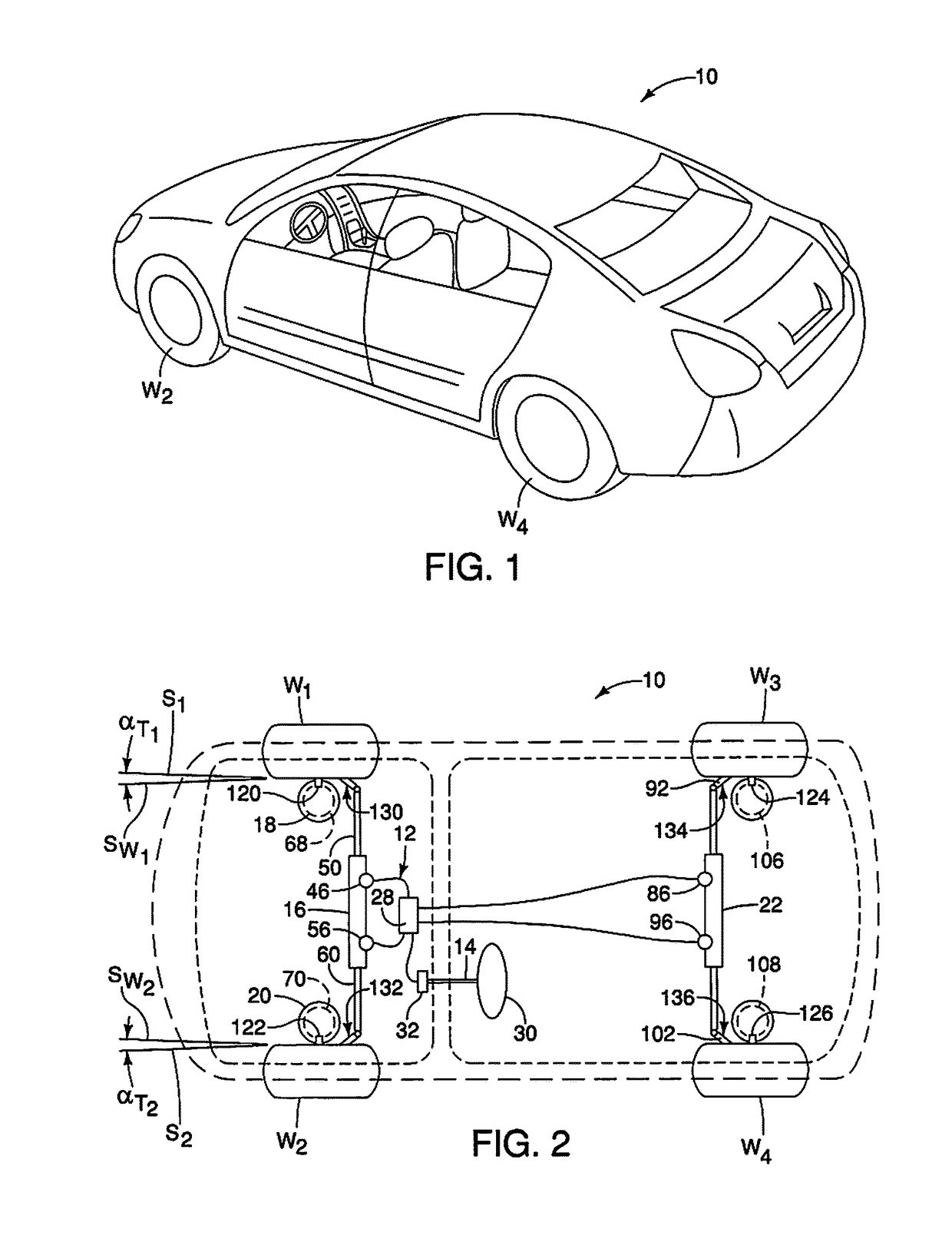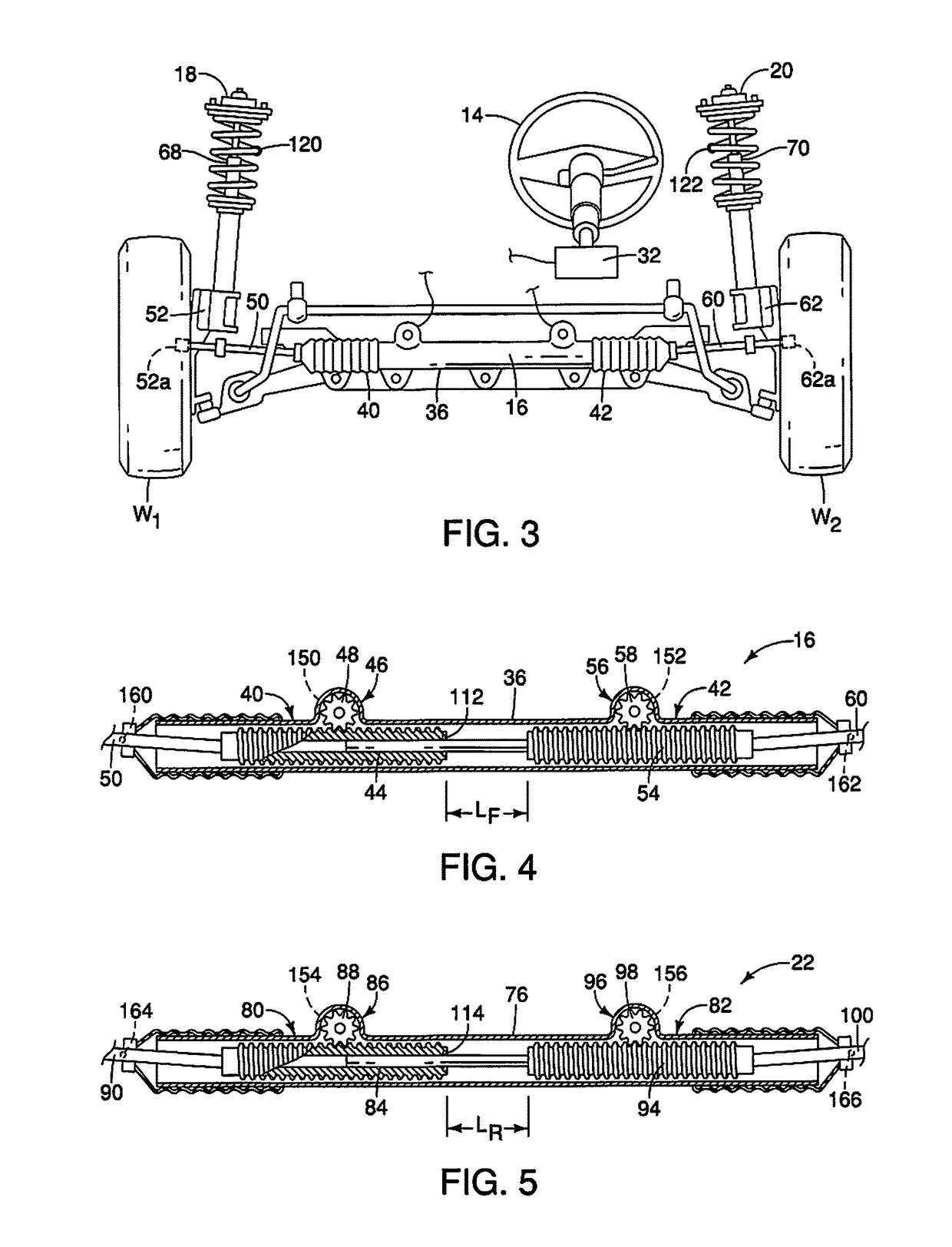Vehicle adaptive steering control apparatus
a technology of steering control and steering mechanism, which is applied in the direction of steering linkage, electrical steering, transportation and packaging, etc., can solve the problems that conventional ackermann steering geometry based steering mechanisms have no means for making adjustments in the movement of steerable wheels, and the geometry based steering system does not necessarily take into account. , to achieve the effect of optimizing driving performance, reducing tire slippage, and reducing tire wear
- Summary
- Abstract
- Description
- Claims
- Application Information
AI Technical Summary
Benefits of technology
Problems solved by technology
Method used
Image
Examples
second embodiment
[0087]Referring now to FIG. 12, a tire load calculation operation S5′ in accordance with a second embodiment will now be explained. In view of the similarity between the first and second embodiments, the parts of the second embodiment that are identical to the parts of the first embodiment will be given the same reference numerals as the parts of the first embodiment. Moreover, the descriptions of the parts of the second embodiment that are identical to the parts of the first embodiment may be omitted for the sake of brevity. The parts of the second embodiment that differ from the parts of the first embodiment will be indicated with a single prime (′).
[0088]In the second embodiment, all of the features described above in FIGS. 1-10 are included except for two modifications and addition of different load detection sensors.
[0089]Specifically, as shown in FIGS. 4 and 5, the motor 46 is provided with a sensor 150, the motor 56 is provide with a sensor 152, the motor 86 is provide with a...
third embodiment
[0093]Referring now to FIG. 13, a tire load calculation operation S5″ in accordance with a third embodiment will now be explained. In view of the similarity between the first and third embodiments, the parts of the third embodiment that are identical to the parts of the first embodiment will be given the same reference numerals as the parts of the first embodiment. Moreover, the descriptions of the parts of the third embodiment that are identical to the parts of the first embodiment may be omitted for the sake of brevity. The parts of the third embodiment that differ from the parts of the first embodiment will be indicated with a double prime (″).
[0094]In the third embodiment, all of the features described above in FIGS. 1-10 are included except for two modifications and addition of supplemental sensors.
[0095]Specifically, as shown in FIGS. 4 and 5, the tie rod 50 is provided with a sensor 160, the tie rod 60 is provide with a sensor 162, the tie rod 90 is provide with a sensor 164 ...
fourth embodiment
[0099]Referring now to FIG. 14, a wheel steering mechanism 222 in accordance with a fourth embodiment will now be explained. In view of the similarity between the first and second embodiments, the parts of the second embodiment that are identical to the parts of the first embodiment will be given the same reference numerals as the parts of the first embodiment. Moreover, the descriptions of the parts of the fifth embodiment that are identical to the parts of the first embodiment may be omitted for the sake of brevity.
[0100]The wheel steering mechanism 222 can replace one or both of the front wheel steering mechanism 16 and / or the rear wheel steering mechanism 22 of the first embodiment. The wheel steering mechanism 222 includes a right wheel steering portion 280 and a left wheel steering portion 282 that are identical, separate and spaced apart from one another. Since the right wheel steering portion 280 and the left wheel steering portion 282 are identical, description of one appli...
PUM
 Login to View More
Login to View More Abstract
Description
Claims
Application Information
 Login to View More
Login to View More - R&D
- Intellectual Property
- Life Sciences
- Materials
- Tech Scout
- Unparalleled Data Quality
- Higher Quality Content
- 60% Fewer Hallucinations
Browse by: Latest US Patents, China's latest patents, Technical Efficacy Thesaurus, Application Domain, Technology Topic, Popular Technical Reports.
© 2025 PatSnap. All rights reserved.Legal|Privacy policy|Modern Slavery Act Transparency Statement|Sitemap|About US| Contact US: help@patsnap.com



